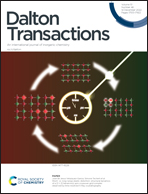Fe-doped carbonized polymer dot-based fluorescent sensor with “turn-on” property for hydrazine hydrate detection†
Abstract
It has become a significant problem to develop and improve carbonized polymer dot (CPD)-based fluorescence sensors with environmental detection features. In this study, fluorescent “turn on” sensors of CPDs were prepared by a one-step hydrothermal method using o-phenylenediamine (o-PD) and ferric chloride (FeCl3) as raw materials. Fe-doped CPDs exhibited excellent fluorescence properties, stability, and the sensitive and selective “turn on” detection of hydrazine hydrate (N2H4·H2O). In this detection system, Fe3+ acts as an effective fluorescence inhibitor that inhibits the yellow fluorescence emission from CPDs, while Fe3+ is reduced upon the addition of the N2H4·H2O reducing agent. The fluorescence intensity of CPDs gradually increased with the increasing concentration of N2H4·H2O, while the limit of detection (LOD) could reach 0.168 μM. In addition, CPD-based polyvinyl alcohol (CPDs@PVA) films were also prepared, which still maintained excellent sensitivity to N2H4·H2O. The results show that CPDs and their composite films can detect N2H4·H2O with good detection performance.



 Please wait while we load your content...
Please wait while we load your content...